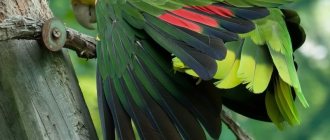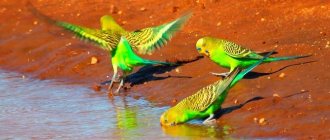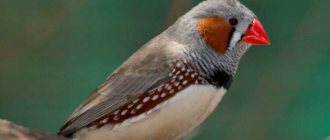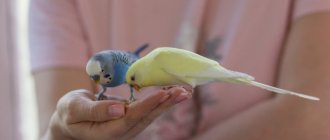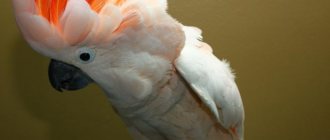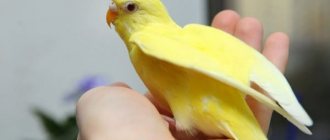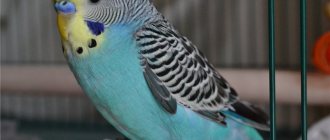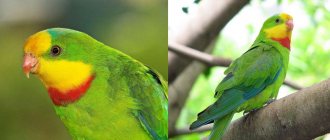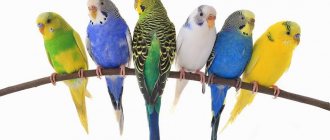Charming birds with bright plumage have long won the love of humans. Parrots reciprocate, and are one of the few birds on the planet that trust people.
Parrots have an amazing ability to reproduce various sounds, including imitating human speech. Undoubtedly, the most beautiful parrots are an adornment of wildlife. Amazing and unique birds often become pets and the pride of world zoos.
Here are the most beautiful types of parrots according to most-beauty.ru:
1
Nestor-kaka
A parrot with an unusual species name lives in the mountain forests of New Zealand.
The plumage of Nestor Car is dark brown with an amazing olive tint. The head is covered with gray feathers, and at the back of the head there is a red band.
Parrots of this species love to spend time among the tops of tall trees and rarely go down to the ground. Parrots have a brush on their tongue with which they suck nectar from flowers.
2
Internal
Now let's consider the internal structure of a feathered friend, because basically all vital processes take place inside, if they stopped, the bird would not be able to exist. A parrot has 46 chromosomes, just like humans.
Voice apparatus
They have an amazing vocal apparatus, thanks to which they can reproduce various sounds, including human speech.
Birds remember sounds and, with the help of a special structure of the vocal apparatus, are able to reproduce them, as well as produce beautiful singing. They have four modulators, while humans have only one.
Respiratory system
The respiratory system allowed oxygen to enter the bloodstream. Due to the high metabolic rate required for flight, birds experience an increased need for oxygen. The development of an efficient respiratory system allowed the evolution of flight. Birds ventilate their lungs using air sacs. Air sacs can account for up to one-fifth of the body's volume!
They breathe through their nostrils, which are located at the top of the upper beak. From their nostrils, air enters a series of nasal cavities, where the air is cleared of dust and particulate matter. From the nasal cavities, air then passes through the trachea to the syrinx, where the air flow is divided into two parts. Instead of going directly into the lungs, the air first enters the air sacs. It takes two inhalation/exhalation cycles for the air to completely pass through the air sacs and lungs.
The cardiovascular system
The cardiovascular system is responsible for delivering oxygen to the body's cells and also plays an important role in maintaining body temperature. The parrot's circulatory system consists of the heart plus all the vessels used to transport blood (arteries, veins, capillaries).
Like mammals, the heart has four chambers, two atria and two ventricles, which act as two separate pumps. After passing through the body, the blood is pumped under high pressure to the lungs. Upon returning from the lungs, it is pumped under high pressure into the body.
Digestive system
The feathered fellow has some unusual features that help him quickly process food. Birds have high energy demands and therefore need to digest their food very efficiently.
Birds' mouths are very different from ours, and they don't chew like we do. There are no teeth and there is no saliva in the mouth. When they eat, they use their beaks to open seeds, nuts and fruits.
The internal parts of digestion are the liver, gall bladder, intestines, pancreas, stomach and goiter.
Nervous system
The nervous system consists of the brain, spinal cord, and nerves that run throughout the body. Main functions of the nervous system:
- Coordinate body actions by transmitting signals;
- Provide sensory information about the internal and external environment;
- Store information as memory.
Excretory system
Chemical digestion of birds and absorption of nutrients occurs in the small intestine. The small intestine of birds receives bile from the liver and digestive enzymes from the pancreas, which help in this process.
The remaining materials then pass through the colon, which consists of a short colon. Finally, the gastrointestinal tract ends at the cloaca, where fecal and urinary material is collected before it is excreted through the anus.
The urinary system is the body's waste removal system. The main function of the kidneys is to process and remove waste from the blood.
Reproductive system
The genital organs of birds are not particularly developed. Males lack a penis. In order to transfer the ejaculate to the female, the male climbs on his back, the holes are compressed, since the male does not have a penis.
Once intercourse is complete, the sperm travels up the oviduct to the egg, where fertilization occurs. The fertilized egg connects to the yolk sac, both return down the oviduct to an area where a membrane forms around them, and are then expelled through the opening of the locula.
Budgerigar
The most popular species of the parrot family on Earth, the budgerigar, comes from Australia.
The parrot has a bright, unique plumage. Travels long distances in search of food. One of the special properties of this bird is the ability to remember and reproduce various sounds. Easily remembers words and phrases, but pronounces them without a logical connection.
As an interesting fact, it can be noted that today there are more budgerigars in captivity than in the wild.
3
Varieties of parrots
There are many varieties of the popular beautiful bird. The photo of parrots shows the most common representatives:
Please note ⭐⭐⭐
Domestic duck: varieties and rules for caring for them, how to breed ducks at home
Domestic hedgehog: rules for keeping it at home, tips for choosing an animal (120 photos)
Domestic ferret (ferret): features of keeping and caring for the animal, standards, types of breeds, what they eat, how long they live (photo)
Greater yellow-crested cockatoo
One of the largest representatives of the cockatoo family, the large yellow-crested cockatoo has chosen to live on the coasts of Australia, Papua New Guinea, the islands of Tasmania and Kangaroo.
A beautiful bird with white plumage is distinguished by a yellowish collar on its head. It is a collective bird; their flocks number 60–80 individuals.
It quickly becomes attached to a person and is easy to train. Parrots of this type of cockatoo can often be found performing in the circus arena.
4
Content Features
To keep a parrot you will need a rectangular cage. Its size should be such that the bird can freely spread its wings and fly from perch to perch. For ease of cleaning, you should choose a cage with a retractable tray. The cage contains:
- wooden perches of such a diameter that the parrot cannot completely wrap his fingers around them;
- two feeders - for dry and succulent food;
- drinking bowl;
- bathing suit;
- toys (wooden or rope);
- mineral supplements (sepia or special mineral stone).
The cage is placed near the wall at the level of the person’s face. It should not be in a draft or in the aisle. Tamed birds can be released from the cage to walk around the room. The water in the drinking bowl and bathing basin is changed daily or more often as it gets dirty. The diet should include:
- grain mixture;
- vegetables;
- fruits;
- greenery;
- boiled egg;
- low-fat cottage cheese;
- porridge cooked in water;
- insects
You can place branches of fruit trees in the cage, which serve as toys for parrots and a source of nutrients. In addition, birds are offered toys purchased at a pet store or home-made toys. They should be made from natural materials and not contain paint, which may be toxic to birds. Toys can be intended for:
- grinding off beak and claws;
- climbing and hanging (ropes, swings, ladders);
- environmental enrichment (educational toys).
On a note! Toys that make sounds are not recommended to be placed in a cage. They can cause stress in birds and also distract parrots from interacting with humans and remembering words.
Arantiga Yendaya
Michael Spencer
This colorful and bright bird nests mainly in Brazil. It feeds on seeds and tree fruits. Arantiga Yendaya is also a frequent visitor to the corn fields.
Parrots live, except for the mating season, in small flocks, choosing the tallest trees, where they make their nests.
5
Rock (Patagonian) parrot
Gerzo Gallardo,
A parrot with amazingly colored feathers lives in the deserted places of the foothills of the South American Andes.
They try not to keep them at home because of their sharp, sometimes unpleasant and loud voice. But in zoos the Patagonian parrot feels great.
He can learn a few words and has a trusting attitude towards people.
6
Lovebirds
There are a huge number of species of parrots in the world, but among all of them we are most attracted to lovebirds, which cannot live without a mate. They are so adorable that everyone loves them.
They are known for their adorable colors and affection. These birds remain faithful to their other half until the end of their lives. For this reason they are called lovebirds.
They nest in tree hollows. Despite their popularity, they are difficult to tame, but they can be trained to perform various tricks and imitate human speech. Possessing a very harsh voice, they are quite warlike towards other birds.
Broad-tailed loris
There are six species of these beautiful and charming parrots living in the wild. The tail is of an unusual rounded shape with wide tail feathers.
The plumage features rich red feathers. The favorite delicacy of brightly colored birds in nature is nectar and juice of tropical fruits. In captivity, people try to maintain this diet with the addition of seeds and small fruits.
7
Human use of parrots
Since ancient times, people have used parrots as expensive, exotic gifts from warm countries. Since then, parrots, primarily speaking ones, have been kept in captivity.
In addition, parrot meat is consumed by Aboriginal tribes in the territories where the birds live. The lifespan of wild birds differs from that of domestic parrots by about 60-70% less.
Bronze-winged Parrot
Photo credit: © Félix Uribe / flickr.
The feathered inhabitant of moist deciduous forests lives in the territory of small states in northern Latin America.
This type of parrot has a dark color with a blue tint. The upper tail part and the tail itself of the bird are bright blue, and the rounded beak is bright yellow.
Bronze-winged parrots live in small flocks. In search of food, they often fly from place to place. By the way, on our website most-beauty.ru you can get acquainted with the most beautiful birds of our planet.
8
Kea
The world's only mountain parrot, Kea, has an olive green coloring. These birds have a beautiful bright orange color under their wings and a grey-brown upper beak. Keas are omnivores. They eat leaves, insects, drink nectar, etc.
These are very smart parrots. To get food, they can solve logic puzzles (for example, moving a thing from one place to another). The circus is the real calling of Kea parrots. They are rightly called the “clown of the mountains.”
Yellow-cheeked rosella
Author: © Luke Durkin / flickr
The smallest bird of the genus Rosella has settled in the southern part of Australia and the islands closest to the continent.
The birds have bright red, green and black colors. There are bright yellow spots on the cheeks, which gave the small parrot its name.
Swarms of yellow-cheeked rosellas are a real disaster for local farmers. But, despite the harm caused by beautiful birds, people do not persecute them.
9
Woodpecker parrots
The smallest representatives of the family. They live in the tropical forests of the island of New Guinea. Their size does not exceed 10 centimeters in length. They can be distinguished from other small birds by their strongly curved beak.
It is very difficult to keep them in captivity, since they:
- They love to fly and cannot stand being in a cage for long periods of time.
- They need special food, the basis of which should not be grain mixtures, but fruits and berries.
Solar aratinga
A parrot with a cheerful, romantic name nests in palm groves and savannas of South America.
Among its brethren it is recognizable by the bright yellow color of its feathers. The parrot has orange circles on its head near its eyes. The long feathers of the wings and tail are brightly colored in dark green shades.
The bird began its acquaintance with Europe from London. It was to this city that the Solar Aratinga was first brought in 1862.
10
fan parrot
Jonathan Wilkins,
A parrot with an unusual fan-shaped plumage on the back of its head lives in South America. During irritation, the movable feathers of the back of the head rise like a collar.
This bird lives far from human habitation in inaccessible tropical forests.
Often becomes a pet due to its calm nature. Gets used to a person, completely trusting him, and quickly becomes tame.
11
Health and life expectancy
The lifespan of small birds is 5-20 years and depends on what species they belong to. Woodpecker parrots live the shortest of all. But lovebirds can live up to 15-18 years.
Small parrots do not have strong immunity and often suffer from infections. Therefore, at the first symptoms of illness or any deviations in the behavior of the birds, they are shown to a veterinarian.
Due to their small size, small parrots are often injured when they get tangled in curtains or crash into a window frame. They also become prey to other pets or a victim of careless treatment by the owner's children. Therefore, birds should not be released from the cage unattended.
Small parrots are quite curious and often drown in vessels with water, are poisoned by vapors of toxic substances, or get burns. They also have a weak heart and are prone to stress. Therefore, tiny birds need to be protected from any emotional outbursts.
Multicolored lorikeet
This amazing bird has collected all the colors of the rainbow in its plumage. Even the lorikeet's beak is an original orange color.
The handsome man lives on the islands of Oceania and in the northern and eastern parts of Australia.
In addition to eucalyptus forests, they settle in cities in trees in close proximity to human habitation.
Due to its unusual color, this species of parrot is the most popular in European zoos.
12
Jaco
The homeland of these birds is Africa. Jacos cannot be called bright and unforgettable. The main color of the plumage is ash-gray, the feathers are slightly lighter at the edges, and the tail is purple-red. Their beak is black and curved, and their legs are also gray.
But these are the most talented parrots, memorizing 1500 words. They begin to be trained at 7-9 months of age. In addition to human speech, Grays also reproduce other sounds: they can scream piercingly, squeal, click their beaks, and often repeat all the sounds that they constantly hear: the sound of a telephone, an alarm clock, the cries of wild birds.
If the gray is not properly kept, has some kind of psychological trauma or parasitic diseases, it may suffer from self-plucking.
Corella
Corella belongs to the genus of cockatoos, and like all representatives, wears an amazing crest on its head.
The charm of the bird is not only the crest, but also the plumage of a dark olive color with a gray tint. The head with all sorts of shades of feathers and a small beak, according to most-beauty.ru, also distinguishes the parrot from many other species.
The bird reproduces easily in captivity, which has allowed humans to breed specimens of various colors.
13
External
Let's consider the external structure of birds, because first of all we pay attention to it because of its rather bright plumage and unusual body structure.
Head
Typically, parrots have a small head, which they can sometimes turn one hundred and eighty degrees. It may appear to be missing a neck due to its plumage. The feathered head immediately begins to connect with the spine. The head contains the eyes, nose and beak of a parrot, so it is quite an important part of the body.
Eyes
Birds have the best vision in the animal kingdom and this is their main advantage. Vision is the most important sense of a parrot as it is important to its ability to survive. Parrots' ability to see with great accuracy over long distances, in enhanced color, helps them detect predators. With their eyes located on the sides of their heads, they are better able to observe movement from all angles and have close to 360° vision.
Beak
The shape of a bird's beak determines its type of diet. The parrot's beak is very strong, as evidenced by its ability to crack nut shells and eat thick-skinned fruits. Birds can use their beaks to delicately groom their own plumage, as well as that of their comrades! All in all, the beak is an amazing tool!
Instead of human teeth, birds have a beak. The upper part of the beak is a soft mound in which the nostrils are located. The color of the bridge of the nose at the base of the beak varies from species to species. Males usually have a bluish beak bridge, while females have a beak, brown and similar colored nose bridge.
Organs of hearing, taste, smell, touch
Instead of ears, birds have ear openings! These ear openings are hidden by special feathers known as auricles. Although parrots do not have external ear structures, they do have three inner ear chambers like ours. The middle ear of a bird has only one bone, compared to the three bones found in human ears.
- Birds can hear a smaller range of sound than humans.
- Birds are less sensitive to the upper and lower limits of the frequency range.
- Birds can distinguish rapid fluctuations (changes) in height and intensity much better than humans.
The tongue is strong and wide, but there are no teeth. Their tongues help them eat fruits, seeds and so on. Their nose is located at the base of the beak, in the soft area.
The skin has sensory nerve endings that detect temperature, pressure, and pain.
Wings
The bone structure in a bird's wing is very similar to a human hand. The wing is built from several types of feathers. Primary feathers are those associated with the skin over the bones, and secondary feathers are those associated with the skin surrounding the bones of the “forearm.”
Both sets also have a layer of coverts on top of them, followed by another layer of edge coverts. On the inside of the wing there are scapulars, sometimes also called tertiaries. Now you can understand how a parrot flies.
Tail
The tail consists of the tailbone, a set of feathers, and a layer of covering feathers at the base of the tail. The coccyx is a group of six fused vertebrae called the pygostyle that supports the tail feathers. The tail feathers are collected in pairs. Starting with the outer pair of tail feathers, each subsequent pair of tail feathers overlap each other. The sacral muscles control both the pygostyle and tail feathers. Some species can open their tails like fans and often do so when they are excited.
A bird's tail is important for flight because it provides lift for most of the body.
The tails of birds also provide balance when sitting on a branch.
Legs
Birds spend almost 24/7 on their feet, even when they sleep. The only time they don't use their legs is when they're flying.
One of the unique anatomical characteristics of a parrot is the arrangement of its toes. The foot has two toes pointing forward and two toes pointing backward.
- The bird's finger is unique. Each parrot's toe has a different number of bones!
- Do you know why he doesn't fall off his perch when he sleeps? There are tendons in each leg that can attach the legs well to the branch.
- Groups of nerve endings that are found in the pads of a parrot's toes - these nerve endings are very sensitive to vibrations and can serve as a warning device to alert the bird to the possible movement of a predator in its environment.
Skin and plumage
The bird's skin is covered with feathers, with the exception of its legs. No sweat glands. To stay cool, birds rely on evaporative cooling through respiration. Up to three-quarters of the air the bird breathes is used for this purpose.
Feathers are unique to parrots and give them their distinctive appearance. Parrots have between 2000 and 3000! The three most common categories of feathers, each serving a specific purpose:
- The flight arms, which are located on the wing and tail, are long, strong and flexible to provide flight power;
- The outline or body feathers that provide the bird's smooth shape and color;
- Soft and fluffy down helps insulate the body from external factors.
Sometimes you can tell whether a bird is healthy or sick just by looking at its feathers. A healthy bird will have shiny, brightly colored and smooth plumage. In contrast, the feathers of a sick, stressed or malnourished bird often have stress streaks or are dull, discolored and rough in appearance. Poor condition in many cases is simply the result of poor nutrition, hygiene and lack of bathing facilities.
Helmeted Cockatoo
JJ Harrison (https://www.jjharrison.com.au/)
This cockatoo with a bright orange head and crest breeds in Australia.
The color of the head differs sharply from the color of the body, wings and tail. It lives mainly in eucalyptus forests at an altitude of approximately 1,500–2,000 meters above sea level.
14
Macaw
Perhaps the most beautiful genus of the parrot family is Ara. These beautiful parrots have bright, rich feather colors. In nature, you can find parrots with red, yellow, green and blue colors.
The pride of this parrot is its beautifully shaped beak, which is also the strongest on Earth among the entire class of birds.
Macaws thrive in captivity and can live up to 75 years. They quickly get used to people. Documents confirm that these parrots were kept in their homes by the Indians of pre-Columbian America.
15
Amazon
Like most parrots, Amazon parrots are characterized by their green color that covers all the edges of their body, as well as the red color that appears on their foreheads.
Like all tropical parrots, the Amazon has a strong personality and needs a lot of attention.
Among all birds, parrots are undoubtedly the most attractive, and thanks to their developed speech apparatus they are very close to people, although they only imitate the sounds they hear.
The most beautiful parrots in the world described above are the most famous to people. We may think we know enough about these birds, but if we think about it, we don't know that much. However, it is known for sure that when a person chooses poultry, most people choose parrots.
Inca cockatoo
This amazingly beautiful parrot nests in eucalyptus forests in the south and west of the Green Continent. This is a rare species on the planet, as it is often forced out of its habitat by other birds.
The belly and back of the Inca Cockatoo have a delicate light pink color of feathers, the wings are white. The crest on the head has a bright color of red and yellow stripes.
Photo credit: © Richard Fisher / flikr
The Inca cockatoo is protected in all states of Australia. The catching and sale of this bird is prohibited throughout the world.
